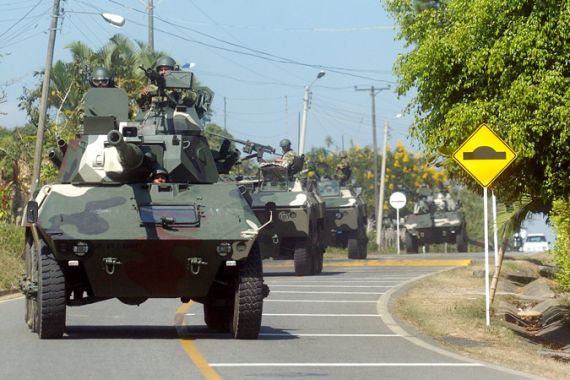Profile: The FARC
The Revolutionary Armed Forces of Colombia, a self-described “peasant army,” have fought a guerrilla war since 1964.

The Revolutionary Armed Forces of Colombia, a self-described “peasant army” first formed by members of the Colombian Communist Party, has been fighting a guerrilla war to overthrow the government since 1964.
Known widely by its acronym, FARC, the movement grew out of years of conflict in the 1950s and 1960s between rural, agrarian communities that communists had tried to organise and the national government, which was trying to industrialise the country after a devastating civil war.
The Colombian government and other detractors accuse the modern-day FARC of using wanton bombings, kidnappings, assassinations and extortion to finance itself and further its goals, and the group has been labeled a terrorist organisation by the United States, which has provided Colombia with billions of dollars worth of assistance to combat the guerrillas.
 |
| The FARC has lost two top leaders in the past four years, and its ranks have been severely thinned by desertions and aggressive Colombian military action [GALLO/GETTY] |
Human rights organisations have condemned the FARC’s used of child fighters and its indiscriminate targeting of civilians, and a 2005 International Crisis Group report claimed around 65 of the movement’s 110 operational units were involved in the cocaine trade.
The FARC has benefited from Venezuelan sponsorship, and documents recovered in 2008 from the computer of slain rebel commander Raul Reyes indicated that President Hugo Chavez and others may at various points have funded and supported FARC activity for strategic benefit against Colombia and the United States.
In 2012, after releasing its last remaining military and police hostages, and in the wake of military setbecks and the loss of top leaders, the FARC entered into negotiations with the government for a final peace. Hundreds of civilians are thought to remain held in FARC custody.
Bloody beginnings
The group’s roots lie in what is known in Colombia as La Violencia, a bloody period in the 1940s and 1950s sparked when Jorge Eliecer Gaitan, a popular left-wing politician, was assassinated, leading to a wave of violence between right-wing and left-wing armed groups.
The civil war left up to 300,000 people dead and spawned several groups, including the FARC, the National Liberation Army and 19th of April movement.
In the wake of the violence, a national government negotiated between conservatives and liberals sought to improve the country’s economy through industrialisation, leading to the eviction of thousands of farmers and conflict with communist-influenced agrarian communities.
FARC was born when Manuel Marulanda Velez, a member of the Communist party, declared one such community, Marquetalia, autonomous and escaped into the mountains with a small group of fighters after a large government attack.
The movement developed a formal army structure in the 1980s, organising into squads and fronts governed by a seven-member secretariat, and was was believed to have boasted about 16,000 fighters in 2001, though that figure later decreased to between 6,000 and 8,000, according to the government.
The group was led by Manuel Marulanda, nicknamed “Tirofijo” or “Sureshot” because of his reported shooting skills, until his death from a heart attack in March 2008. FARC second-in-command Raul Reyes had been killed earlier that year.
Marulanda was replaced by Alfonso Cano, a former anthropologist and ideological leader of the FARC, but Cano was killed in November 2011.
Negotiations
The FARC has been involved in on-off peace negotiations with the Colombian government since 1984, when it set up a political party, the Patriotic Union, to achieve its ends.
But the party was undermined by a series of assassinations by right-wing paramilitaries and in 1985, the group returned to its armed campaign.
In 1998, President Andres Pastrana allocated 42,000 square kilometers of territory for the FARC, a safe haven that the group had considered a pre-condition for peace talks.
But within four years, negotiations stalled after attacks continued, and Pastrana ordered the army to retake the territory.
National politicians including Ingrid Betancourt, a former presidential candidate, have been among FARC’s many hostages, who were typically held in poor conditions, sometimes in cages deep in jungle areas.
One hostage released by the Farc said he and others had suffered “subhuman conditions” during their captivity.
In April 2012, the FARC released four soldiers and six police officers whom it had held for 14 years, men believed to be the movement’s last military or police hostages. But the Pais Libre Foundation estimates that the group has not freed more than 400 civilians kidnapped for ransom.
Decline
FARC’s recent decline began after the hardline Alvaro Uribe was elected president of Colombia in 2002. Uribe’s father, his predecessor in the presidency, had been a wealthy landowner and was assassinated by the FARC during a failed kidnapping attempt.
Uribe intensified the military assault on the FARC, and the Colombian army’s better-equipped forces, trained and advised by the United States, scored a number of significant victories.
A number of senior commanders have been killed, including Reyes, who died in a controversial cross-border raid on a FARC camp in Ecuador, which sparked a still-lingering diplomatic crisis in the region.
The group has also suffered serious desertions, with some fighters becoming disillusioned by involvement in the drug trade.
Juan Miguel Santos, who succeeded Uribe in 2010, has improved relations with Venezuela and Ecuador, though it remains to be seen whether his effort to begin final peace talks with FARC – as well as the National Liberation Army – will be welcomed or successful.